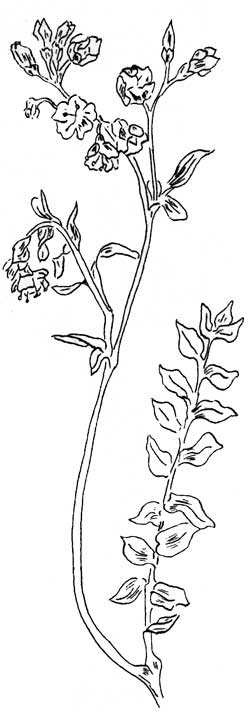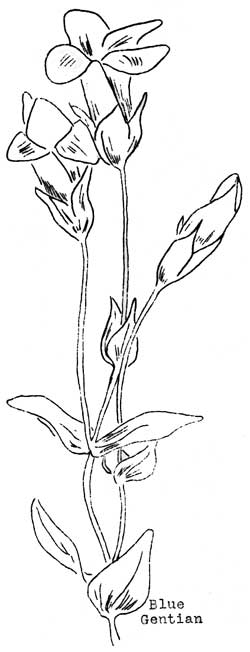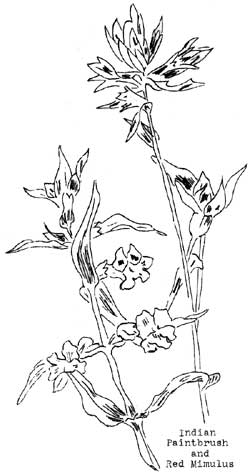

Jacob's Ladder |
Albinism is not uncommon among wild flowers in Mount Rainier National
Park. During the summer season of 1934, albino blossoms of the following
were reported: Blue Lupine (Lupinus latifolius and L. volcanicus), Blue
Gentian (G. calycosa), Indian Paintbrush (Castilleja miniata and C.
oreopola) and Butterfly-tongue Lousewort (Pedicularis groenlandica).
Numerous albino blossoms have been reported in past seasons
including, in addition to those mentioned above, those of the Red
Mimulus (Mimulus lewisii), (Nature Notes, 9/3/1924 - Macy), Jacob's
Ladder (Polemonium elegans) and Red Heather (Phyllodoce empetriformis),
(Nature Notes, 8/8/1927 - Schmoe). In the case of one albino mimulus the
same plant apparently was observed to be so characterized on two
successive seasons. An albino gentian has been observed on Mazama Ridge
for three successive seasons (Brockman). Such abnormal flowers have been
reported from many places in the Hudsonian Zone of this park, indicating
a wide distribution of albinos between 4500 and 6500 feet on Mt.
Rainier.
The fundamental principles involved in albinism are fairly well
understood. It is believed that sudden changes may take place in the
form or color of an organism through some change in a definite unit of
the reproductive material from which it originated. (DeVries mutation
theory) Thus an abnormality in the germ-plasm of the parents results in
abnormality of the offspring. In plants, such things as albinism,
multiple rows of petals, seedlessness, thornlessness, etc., may be
explained in that manner. Since these mutations were shown to reproduce
themselves or "breed true", DeVries felt that this was proof that they
originated in abnormalities of the germ-plasm of the parents. Thus,
assuming a germinal change, an albino plant might be expected to
reproduce this character as long as it was either self-fertilized or
cross-fertilized with another albino evolved in a similar manner. This
may be considered as an explanation for some of the albino flowers found
in Mount Rainier National Park. Of course a perennial albino plant
develops white flowers year after year throughout its life.

Blue Gentian |
Schmoe, in reporting the albino red heather, states that only the
blossoms upon one branch of the plant were white. This is known as a
"sport". Such a character is not brought about by an abnormality of the
germ-plasm of the parents. It had its origin in the body tissues of the
plant during its growth. Such "sports" may be perpetuated only by means
of vegetative propogation of the affected portion of the plant itself
which, in the case of the red heather, would probably never occur
naturally. An example of this type of mutation is the seedless
grapefruit. It was propogated vegetatively by man by grafting portions
of the original "sport" upon normal grapefruit stocks.
Many plants are not normally self-fertilized or "selfed". In the
majority of cases cross-pollinization is the rule. The offspring of such
unions contain the characteristics of both parents together with those
of their ancestors. Many of these characteristics are not evident in the
offspring - are subdued or are "recessive". Those that are evident are
known as "dominant". If the pollen produced by a blossom of normal color
is carried to the pistil of an albino (developed through a mutation in a
single factor of the germ-plasm) the seeds produced would contain both
the element for albinism and normal color in equal proportions or
"dosages". However plants grown from this seed would all be normally
colored because the character for color is dominant. Now if these
normally colored blossoms, just described, are self-fertilized the seeds
re sulting from such a union would produce some albino plants and some
normally colored ones; the ration being three normal to one albino. This
is known as segregation.

Indian Paintbrush
and
Red Mimulus |
It is quite evident that the matter of albinism is by no means
simple. Evidence to the effect that not all albinos are caused through
strict mutations, but in many cases through crossing of mutants with
normal blossoms is found in what might be termed "dilutants" -
intermediate stages between the normally colored blossom and the albino
due to incomplete dominance of the normal color. Examples of this have
been especially noticeable in the lupine, individuals having been found
representing almost the entire color range from pale pink to deep
violet. In addition Blue Gentians of an old rose shade have been noted
in close proximity to plants with albino blossoms. The presences of such
variants has not been definitely linked with the albinos in so far as
the flowers of Mt. Rainier are concerned. To establish their origin
definitely will require considerable further study.
The observed albinos, then, may be classed as to their immediate
origin. The majority develop through a sudden mutation brought about by
an alteration in the germ-plasm of the parent, or through segregation
following cross-pollinization in which a mutant is one parent.
Another class (i. e. the Red Heather) is the "sport".
Natt Dodge,
(Ranger-Naturalist, season, 1934) and
LeRoy Johnson,
(Botany Department,
Wash. State College)

